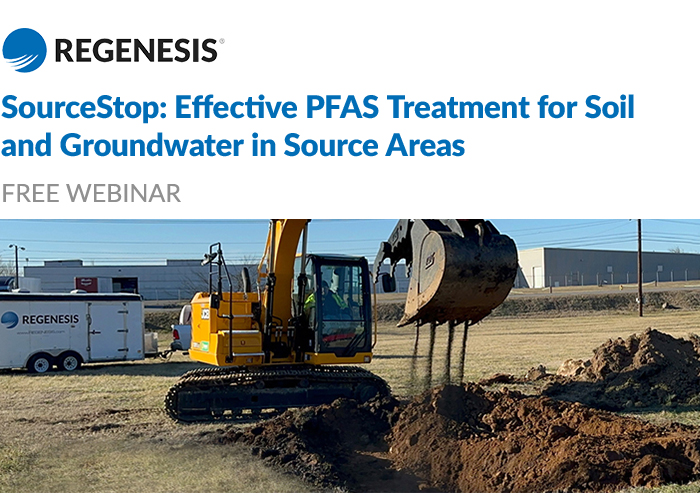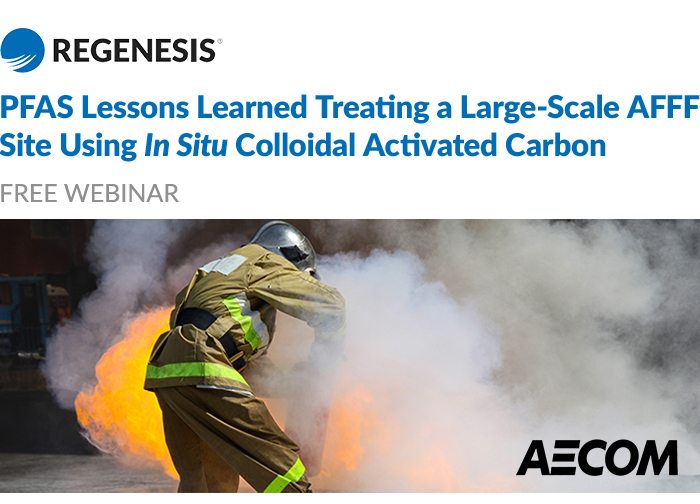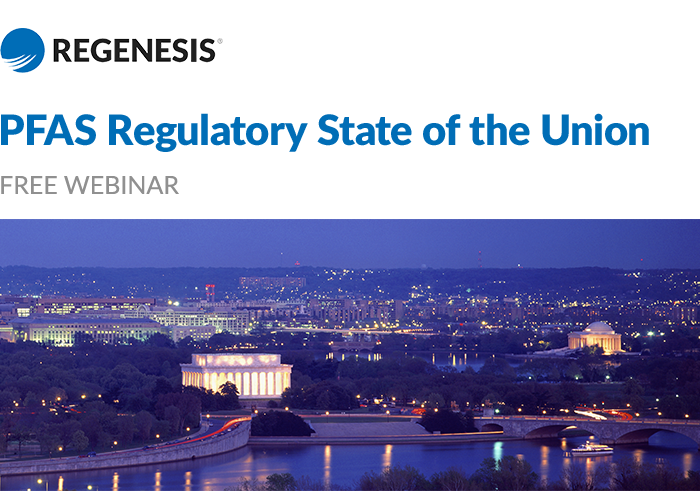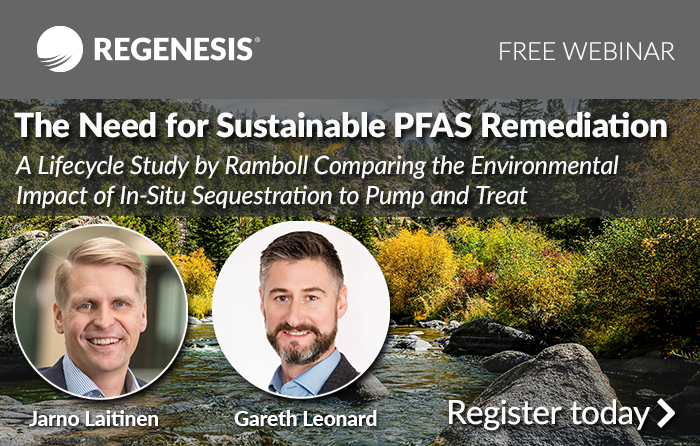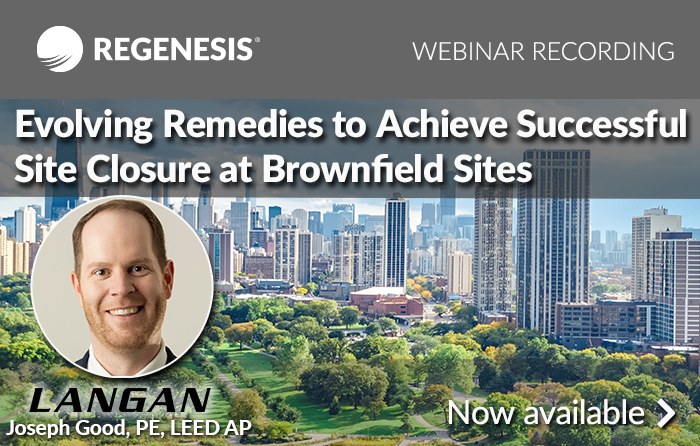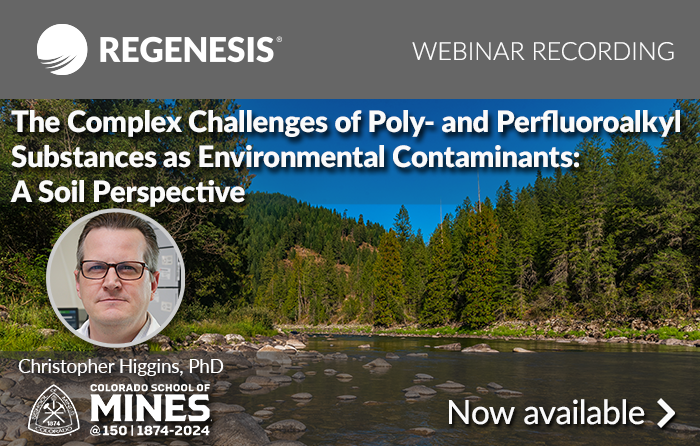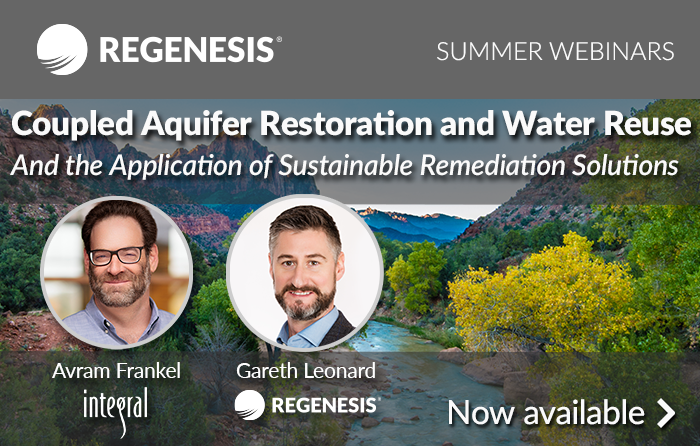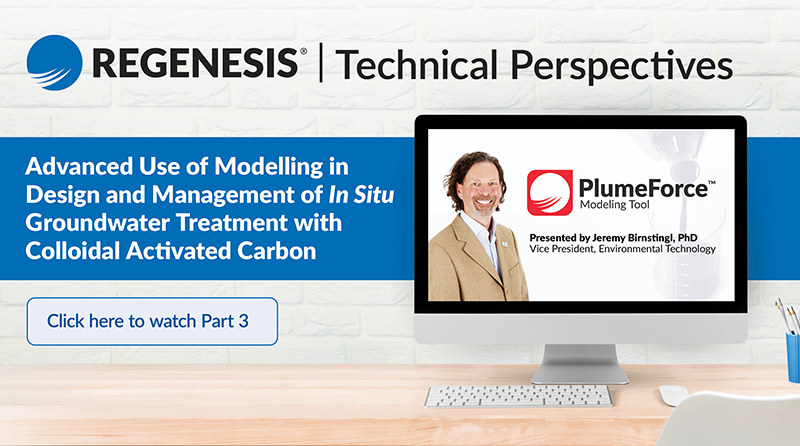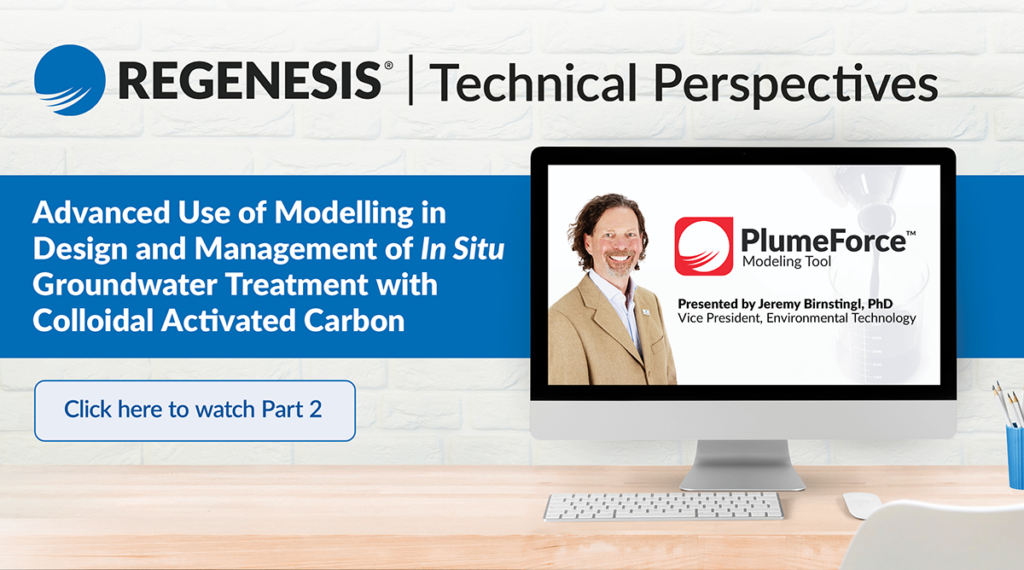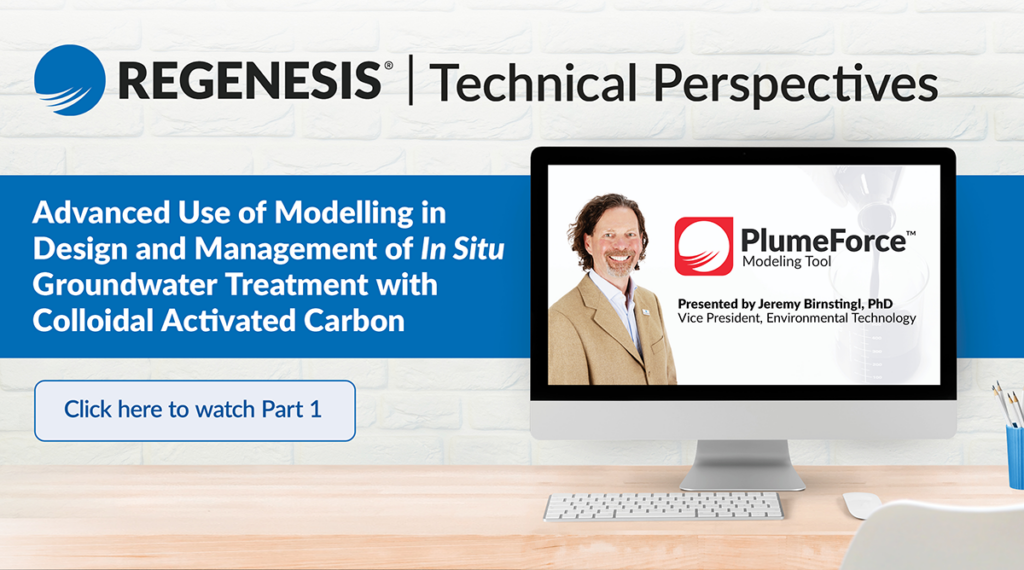SourceStop: Effective PFAS Treatment for Soil and Groundwater in Source Areas
In this webinar we were pleased to have a special presentation by Paul Erickson, PhD, Vice President of Research & Development at REGENESIS, and Steve Barnes, Director of Remediation Services at REGENESIS. Their presentation provided an overview of a new technology for the effective treatment of PFAS-contaminated soil and groundwater in the source area.
Highlights of this free webinar:
- Available in solid and liquid formulations, SourceStop® allows treatment to be customized to meet the specific needs of any site.
- Significantly reduces the leaching of soil contamination and halts the migration of PFAS in groundwater, eliminating risk to downgradient receptors.
- Safe and easy to handle, SourceStop liquid and solid formats can be used independently, in combination, or with a downgradient PlumeStop barrier to provide a complete, low-cost, zero-waste solution for PFAS sites.
Complete the form on this page to view this free webinar.
View webinar recording
PFAS Lessons Learned Treating a Large-Scale AFFF Site Using In-Situ Colloidal Activated Carbon
We were pleased to host Rebecca Mora, AECOM Associate Vice President and Senior Technical Leader who presented PFAS lessons learned while effectively treating a large-scale, AFFF release in situ using colloidal activated carbon (CAC). The complicated, high-concentration site represents one of the longest CAC permeable reactive barriers installed to address PFAS impacts, measuring over 1,600 feet long. She was joined by Ryan Moore, PFAS Remediation Program Director at REGENESIS.
Highlights of this free webinar:
- Approach, lessons learned, and performance results after 2 years of post-injection monitoring from an in situ application of a 1,635-foot-long colloidal activated carbon barrier to mitigate PFAS migration
- Rapid implementation of remedial solution due to perceived regulatory and public pressure
- Treatment addressing high concentrations of PFAS (up to 550 ppb)
- Remedial objective to reduce PFAS concentrations in groundwater migrating towards nearby off-site drainage ditches
Complete the form on this page to view this free webinar.
Recording now available
PFAS Regulatory State of the Union
In this webinar we were pleased to have special guest speaker Taryn McKnight, PFAS Practice Leader for Eurofins Environment Testing. Her presentation discussed regulatory actions at both the federal and state level to address PFAS contamination.
Highlights of this free webinar:
- A catalogue of notable regulatory actions for PFAS and updates on the scientific research driving these regulations
- EPA PFAS regulatory milestones that have been achieved, and ones that have slipped
- Latest news on toxicology, health studies, analytical method development, and understanding the fate and transport of PFAS
2023 issued in a new National Defense Authorization Act, an updated Unified Agenda, a new Mil Spec for fire-fighting foams, and a litany of proposed regulations from TSCA reporting requirements to additional hazard designations for PFAS. As we close out the year, we see that EPA has achieved several of the milestones they had set for themselves while others have slipped. Meanwhile, the states have continued to forge their own paths forward with how to address PFAS contamination. And with rapidly evolving science and technologies there is an immeasurable number of developments to keep track of. This presentation will catalogue notable regulatory actions and provide an update on the state of the scientific research that is driving these regulations.
Complete the form on this page to view this free webinar.
View webinar
The Need for Sustainable PFAS Remediation: A Lifecycle Study by Ramboll Comparing the Environmental Impact of In-Situ Sequestration to Pump and Treat
In this webinar we are pleased to have special guest speaker Jarno Laitinen, Head of Department for Climate and Circular Economy at Ramboll and Gareth Leonard, Managing Director of REGENESIS Europe. Their presentation will discuss a lifecycle comparison done by Ramboll that highlights the use of PlumeStop as being > 95% more sustainable than a pump and treat solution.
Highlights of this webinar:
- Ramboll’s life cycle comparison found PlumeStop to be > 95% more sustainable than a pump and treat solution
- Use of colloidal activated carbon (CAC) requires no operational energy or maintenance, and avoids production of PFAS-saturated waste
- A PlumeStop solution is 61-65% lower in cost as compared to an ex situ treatment approach
This webinar provides a comparison of the environmental impact of long-term in situ sequestration using CAC to pump & treat for PFAS treatment. To quantify the sustainability of this in situ approach, leading global engineering and consulting firm, Ramboll completed a Life Cycle Analysis (LCA) on the CAC material, with boundaries encompassing ‘cradle to grave’: considering upstream material sourcing, core manufacturing processes and the downstream processes of transport and injection. The LCA was undertaken according to ISO14044/ISO14025 by using GaBi Professional software in order to meet EN15804 standards to create an Environmental Product Declaration (EPD). Next, the environmental impact of an actual CAC application downgradient of the PFAS source at a commercial airport was analysed. A comparative analysis was conducted by designing an alternative “pump and treat” system using two filtration techniques and assessing its environmental impact using GaBi Professional software. Additionally, a Life Cycle Cost Analysis (LCCA) was completed using net present value. Finally, a Tier 2 sustainability assessment using Ramboll’s SURE model, considering 15 sustainability indicators, was completed for each remedial approach.
Complete the form on this page to sign up for this free webinar.
Recording Now Available
Evolving Remedies to Achieve Successful Site Closure at Brownfield Sites
In this webinar we were pleased to have special guest speaker Joseph Good, PE, LEED AP, Associate at Langan. His presentation discussed brownfield remediation projects that highlight the importance of evolving remedies for successful site closure. He was joined by Maureen Dooley, Vice President – Industrial Sector at REGENESIS.
Highlights of this webinar:
- Field case studies from urban brownfield remediation sites from investigation phase through treatability studies and field implementation
- Successful adjustments to initial remedial plans due to findings during the field implementation
- Responding effectively to evolving development schedules/plans to facilitate successful completion of the remedial program
Environmental remediations are carefully planned from the extensive field investigations that makeup the basis for design through the research and development of cutting-edge remedial products. Bench-scale studies are performed to confirm applicability and determine design parameters for the in-situ remedy implementation. While the latest scientific research combined with site-specific data may provide confidence in achieving remedial goals, there are often complications with execution of the remedy that require amendments and adjustments to reach the desired endpoint and final site closure. This presentation will include evaluation of multiple urban brownfield remediation sites from investigation phase through treatability studies and field implementation. This presentation will highlight adjustments to initial remedial plans due to findings during the field implementation, subsequent monitoring, and evolving development schedules/plans to facilitate successful completion of the remedial program. Key findings from each project will highlight the importance of evolving remedies to successful site closure.
Complete the form on this page to view this free webinar.
Recording now available
The Complex Challenges of Poly- and Perfluoroalkyl Substances as Environmental Contaminants: A Soil Perspective
In this webinar we were pleased to have special guest speaker Christopher P. Higgins, PhD, University Distinguished Professor, Civil and Environmental Engineering at Colorado School of Mines. He was joined by Paul Erickson, PhD, Director of Research & Development at REGENESIS.
Highlights of this webinar:
- High resolution mass spectrometry reveals additional PFASs that may be associated with AFFF-impacted sites
- The role of the anionic, cationic, and zwitterionic polyfluorinated substances at AFFF-impacted sites that can serve as precursors to the more persistent and mobile PFAAs
- Need for more thorough assessments of soils as potential long-term sources of PFAAs to groundwater and surface waters
The challenges posed by the widespread contamination of soils and groundwater by poly- and perfluoroalkyl substances (PFAS) are immense. Despite growing concerns about human exposure to perfluorooctanoate (PFOA) and perfluorooctane sulfonate (PFOS), other PFAS, particularly those derived from aqueous film-forming foams (AFFF) have garnered little attention. Recent work using high resolution mass spectrometry (HRMS) has revealed that there are dozens, if not hundreds, of additional PFASs that may be associated with AFFF-impacted sites. Importantly, many of these newly discovered PFAS have diverse chemical structures, including anionic, cationic, and zwitterionic structures. Some of these PFAS clearly remain bound strongly to soil, while other AFFF-derived PFAS, including transformation products, likely migrate into AFFF-impacted drinking water. In this presentation, the complex challenges posed by PFAS for human and environmental risk will be presented and discussed. Particular attention will be given to the role of the anionic, cationic, and zwitterionic polyfluorinated substances at AFFF-impacted sites that can serve as precursors to the more persistent and mobile perfluoroalkyl acids (PFAA). Collectively, these data suggest a need for more thorough assessments of soils as potential long-term sources of PFAA to groundwaters and surface waters.
Complete the form on this page to view this free webinar.
Recording now available
Coupled Aquifer Restoration and Water Reuse – And the Application of Sustainable Remediation Solutions
In this webinar we were pleased to have special guest speaker Avram Frankel, PE, Managing Principal, Integral Consulting, Inc. His presentation discussed coupled aquifer restoration and water reuse, and the continuing evolution of an integrated solution. He was joined by Gareth Leonard, Managing Director of REGENESIS Europe, who discussed sustainable remediation solutions.
Highlights of this webinar:
- Successful aquifer restoration strategies integrating groundwater remediation with water supply
- The importance of fully integrated remediation approaches
- Application of water resource management approaches such as Aquifer Storage and Recovery and Managed Aquifer Recharge
Complete the form on this page to view this free webinar.
Recording now available
REGENESIS Technical Perspectives Series Part 3 – Use of Modelling Beyond Design
REGENESIS invites you to a limited educational webinar series presented by Dr. Jeremy Birnstingl, a leading environmental expert, on the application of advanced modelling for in situ groundwater treatment using colloidal activated carbon.
This ground-breaking three-part series provides insights and examples into the power and utility of modelling to assist throughout a project, from conceptional and formal design stages to performance data interpretation, management and optimization.
The series has been developed specifically for environmental professionals focused on optimizing and better understanding best practices when developing designs to maximize the effectiveness and longevity of a remedial solution that incorporates colloidal activated carbon technology.
Part 3: Taking Modelling Beyond the Design
- Modelling as a tool for communication support
- Modelling as tool for managing expectations
- Modelling to assist in performance tracking
- Modelling to support optimization and maintenance
Complete the form on this page to view Part 3 in this free webinar series.
Recording now available
REGENESIS Technical Perspectives Series Part 2 – Using Modelling to Explore Hidden Processes
REGENESIS invites you to a limited educational webinar series, REGENESIS Technical Perspectives, presented by Dr. Jeremy Birnstingl, a leading environmental expert, on the application of advanced modelling for in situ groundwater treatment using colloidal activated carbon.
This ground-breaking three-part series provides insights and examples into the power and utility of modelling to assist throughout a project, from conceptional and formal design stages to performance data interpretation, management and optimization.
The series has been developed specifically for environmental professionals focused on optimizing and better understanding best practices when developing designs to maximize the effectiveness and longevity of a remedial solution that incorporates colloidal activated carbon technology.
Part 2: Using Modelling to Explore Hidden Processes
- Processes in isolation vs processes in combination – emergent phenomena
- Kinetic equilibria – when stall is not a stall
- Impacts of hidden mass – managing the invisible
- Windows into hidden dynamics – implications to project design
Complete the form on this page to view the recording of Part 2 in the REGENESIS Technical Perspectives series.
Recording now available
REGENESIS Technical Perspectives Series Part 1 – PlumeStop® Colloidal Activated Carbon and Modelling
REGENESIS invites you to a limited educational webinar series, REGENESIS Technical Perspectives, presented by Dr. Jeremy Birnstingl, a leading environmental expert, on the application of advanced modelling for in situ groundwater treatment using colloidal activated carbon.
This ground-breaking three-part series provides insights and examples into the power and utility of modelling to assist throughout a project, from conceptional and formal design stages to performance data interpretation, management and optimization.
The series has been developed specifically for environmental professionals focused on optimizing and better understanding best practices when developing designs to maximize the effectiveness and longevity of a remedial solution that incorporates colloidal activated carbon technology.
Part 1: PlumeStop® Colloidal Activated Carbon and Modelling
Highlights of this module in the series include:
- Why modelling and PlumeStop are a natural match
- How to use any model for simple PlumeStop explorations
- The REGENESIS PlumeForce™ modelling software
- Model-based designs
Complete the form on this page to view the recording of Part 1 in the REGENESIS Technical Perspectives series.


 Americas
Americas Europe
Europe Français
Français Deutsch
Deutsch Italiano
Italiano Español
Español